Mon 14 Dec 2009
Frank L. Packard’s JIMMIE DALE – An Overview by David L. Vineyard
Posted by Steve under Characters , Pulp Fiction[28] Comments
An Overview by David L. Vineyard
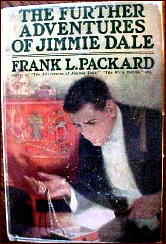
Few characters as obscure as Canadian novelist Frank L. Packard’s gentleman cracksman, Jimmie Dale the Gray Seal, have had the impact and long term import of this one. Almost unknown today, Packard and his creation not only exerted a tremendous influence on the pulps he came from, but established many of the tropes of the modern superhero in comic books.
From his secret lair, the Sanctuary, his multiple identities, and his calling card, a gray diamond paper seal, Jimmie Dale set the pattern for the mystery men and super heroes who will follow.
Jimmie first appeared in the May 1914 issue of People’s Magazine. He is the son of a wealthy safe manufacturer and himself an expert at all sorts of locks and safes. He is also noted for his sense of fun and adventure — which explains in part why he takes on the nom de guerre of the Gray Seal and breaks into the most difficult of safes, stealing nothing and leaving behind a gray diamond paper seal, the mark of the Gray Seal.

Normally he would probably have grown out of this stage, but a mysterious woman will change all that. It begins with a series of letters claiming to know all about the Gray Seal and threatening him with jail.
Soon enough the letters change and the mysterious angel begins to direct the actions of the Gray Seal to correct miscarriages of justice.
Of such things are great careers born.
Jimmie sells his father’s company and sets himself up as an idle playboy with the aid of the faithful butler Jason and his tough chauffeur Benson.
He creates the personae of Larry the Bat, a small time crook and informer, and Smarlinghue the drug addicted artist so he can penetrate the world of crime.
The police and press offer rewards for the Gray Seal; the underworld wants him dead. Jimmie squeaks by on brains, luck, and no little skill. His mysterious female angel calls herself the Tocsin, the Alarm. Soon enough she is revealed to be Marie LaSalle and Jimmie, already half in love with her, falls the rest of the way.
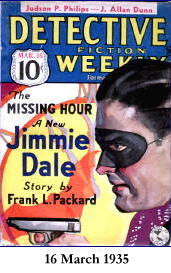
Not that there is much room for romance in the life of the Gray Seal.
Jimmie first appeared in 1914 and made his final appearance in Detective Fiction Weekly in 1935. His adventures are cleverly written melodrama penned by a writer who specialized in books about adventure with backgrounds in railroading, South Seas adventure, and the world of urban crime.
Among his better known books, The White Moll, and The Miracle Man (the latter a famous film with Lon Chaney). His books were frequently brought to the silent screen and his long career successful and rewarding.
But like many popular writers of his time — Harold McGrath comes to mind — he is largely forgotten today. Or would be, if not for Jimmie Dale, the Gray Seal.
Jimmie isn’t entirely original. He borrows elements from Eugene Sue’s Prince Rodolfe, from the Count of Monte Cristo, from Rocambole, from the Scarlet Pimpernel, from Raffles, from O. Henry’s grifters and Jimmy Valentine, from Arsene Lupin and others, but in Jimmie all the tropes of the mystery man and the super hero come together for the first time.
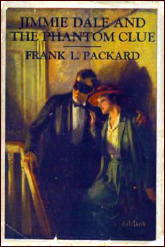 The Adventures of Jimmie Dale appeared in 1917. In 1919 The Further Adventures of Jimmie Dale came along. In 1922 the first novel, Jimmie Dale and the Phantom Clue came out in hardcover.
The Adventures of Jimmie Dale appeared in 1917. In 1919 The Further Adventures of Jimmie Dale came along. In 1922 the first novel, Jimmie Dale and the Phantom Clue came out in hardcover.
Jimmie Dale and the Blue Envelope appeared in 1930 and finally in 1935, Jimmie Dale and the Missing Hour. But as Robert Sampson points out in Yesterday’s Faces, Volume I: Glory Figures, the saga is really one long book, remarkably concise and suspenseful with the tension of a ticking clock.
Frank Packard died in 1942 while working on a new adventure of the Gray Seal.
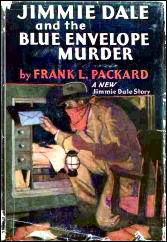
Much of our view of the mean streets and the urban ‘badlands’ comes from Packard’s books and their impact on others who followed in his footsteps. His tales are told in clean straight forward prose by a man of some culture and learning who understood the needs of storytelling and had something to say about salvation and redemption.
Virtually every fictional crime fighter who follows is within his shadow. He is simply one of the genre’s most important archetypes, and the transition figure from the quaint pre-war crime as game to the tough guns blazing sagas of the pulps, films, and comics that follow.
Jimmie may be a romantic and melodramatic figure, but he operates in the world of Hammett and Chandler. That said, Packard does not follow through on the social impact of crime in the same way as the hard-boiled school. He writes superficially about these subjects, but he writes well.
And his adventures are still worth reading. There’s little a modern reader has to forgive and much to praise. It is no small thing to say that Jimmie Dale can still be read for pleasure, not merely nostalgia or his historical importance.
The criminals lurk in the darkness, and the Gray Seal stands ready to strike, and in his wake every masked, caped, and spandex clad hero and mystery man stand ready to carry on his crusade. They are all in his debt, as are we.
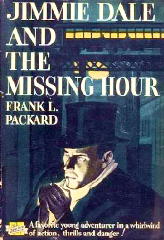
From Lamont Cranston to Bruce Wayne, from Richard Wentworth to Peter Parker, Jimmie Dale and the Gray Seal are where it all truly began, and more than worth revisiting to be surprised at just how much of the genre came fully formed from his adventures.
Note: Norvel Page, who took over the Spider from R.T.M Scott (creator of Aurelius Smith aka Secret Service Smith), was a particular fan of the Gray Seal and used many of Packard’s ideas in the Spider’s saga.
As Page greatly influenced both Michael Avallone and Mickey Spillane, so Jimmie Dale’s influence continues.
While there are other figures of equal importance, some which came before him, Jimmie brings all the elements together for the first time and thus holds pride of place.
December 15th, 2009 at 6:18 am
I agree with this article’s assessment of Packard’s influence. And have long said so on my web site:
http://mikegrost.com/rogue.htm#Secret
December 15th, 2009 at 11:46 am
I have at least three of the Jimmie Dale books, but I’ve never known I should read them until now. (Unfortunately there are no dust jackets on any of mine. The last one, in blue, is rather blah, but each of the others I was able to include with David’s article are quite nice — and if I’d had the covers, chances are I would have read the books. Before now, that is.)
December 16th, 2009 at 3:04 am
Robert Sampson has an in depth look at Dale in his Yesterday’s Faces: Glory Figures Vol. I, and in Superhero: The Secret Origin of a Genre author Peter Coogan discusses the impact and importance of Packard and Dale.
But unlike some historically important creations both Packard and Dale can be read for pleasure. The writing is crisp, the plotting superior pulp, and Jimmie is a fully realized character. It is also interesting to note the similarities between Packard’s Dale and Bruce Graeme’s Blackshirt, though the latter is more of a criminal.
Spider fans in particular will notice how much of Jimmie Dale Norvel Page borrowed for his hero, though Jimmie is considerably saner than Richard Wentworth.
December 16th, 2009 at 3:15 pm
I know Sampson’s fine book, and refer to it on my web site.
But Peter Coogan’s “Superhero” is new to me. Thanks for telling about it!
December 16th, 2009 at 7:06 pm
Mike
Don’t want to mislead you, the passage in the Coogan book is only a few paragraphs, though if you also like comics it is a good overview of the origins of superheroes in popular literature from the days of Spring Heeled Jack to the big budget movies of today.
And I’m probably prejudiced since he quotes me as one of his references on Jimmie Dale and Packard.
December 16th, 2009 at 10:19 pm
David,
It’s great to be quoted. Congratulations!
I am really interested in comic books. And have an especial fondness for superheroes. Favorites: Superman, Green Lantern, the Flash.
There are some very good mystery plots in comic books.
December 17th, 2009 at 1:00 am
FYI: There’s now also an external link to David’s article from the Jimmie Dale page on Wikipedia:
http://en.wikipedia.org/wiki/Jimmie_Dale
— Steve
PS. Mike, I’ve tried to maintain my interest in superhero comics, but the current crop seems to lack something that those back in the Golden Age had, and that’s interesting stories.
Most of today’s heroes have so many psychological handicaps and other hangups that they couldn’t think their way out of a paper bag soaked in water overnight, much less a full-fledged detective puzzle.
If you have any examples that prove me wrong, let me know.
December 17th, 2009 at 2:28 am
While the links between comics and mystery aren’t as strong as those with science fiction a good many mystery writers then and now had ties with either comic strips or comic books. Of course Dashiell Hammett, Leslie Charteris, and Mickey Spillance come to mind, Charteris even writing some of the Avon comic book Saint adventures.
Today Max Allan Collins and Gregg Rukka are the best known names, and of course Peter O’Donnell and Modesty Blaise.
However the most prestigious after Hammett is likely Rex Stout, who with Alexander Woolcott, created the character of Radar, an international agent for the UN as part of their war work for Fawcett comics.
And Ward Greene — Death in the Deep South and Route 28 — wrote Rip Kirby with creator Alex Raymond.
December 17th, 2009 at 3:54 pm
Just thought I would append a list of comic strips and comic book adaptations of mystery characters and fiction. This is by no means all inclusive, and certainly there are too many to begin to include them all. I’m not counting things like Alan Moore’s League of Extraordinary Gentlemen just because it would complicate it all more.
Sherlock Holmes —- too many to count but of note the Frank Giacola comic strip and the two issues of the Gold Key comic book he did, also the early Leo O’Melia strip. Two Classics Illustrated comics. others from DC, Marvel. British, French, everywhere.
Parry Mason — both a comic strip by Frank Thorne, a single adaptation of one of Gardner’s books by Paul Norris, and at least one issue of a Dell comic based on the series with Raymond Burr.
Charlie Chan — a strip by Alfred Androlia (Kerry Drake) and three different comic book, one based on the ABC series The New Adventures of Charlie Chan with J. Carroll Naish. At least one series featured covers by legendary Simon and Kirby.
James Bond — aside from the strip by writer Jim Lawrence and artists John McLusky and Yarloslav Horak, also movie adaptations, original comic book adventures from numerous countries and Marvel Comics James Bond Junior based on the television series.
Bulldog Drummond — one issue, Moonstone Comics
Mr. Moto — three issues Moonstone Comics
Michael Shayne — three issues from Gold Key adapting Brett Halliday’s novels.
The Saint — long running strip by Leslie Charteris and first Mike Roy then John Spang and Dough Wildey. Avon Comic book — original material and reprints.
Nick Carter — back up in The Shadow from Street and Smith with art by S.R. (Bob) Powell.
Sam Spade — one issue adaptation of The Maltese Falcon and Wildroot Hair Creme ads in Sunday papers by legendary comic book artist Lou Fine.
Dr. Fu Manchu — strip by Leo O’Melia, one issue Avon adaptation of The Mask of Fu Manchu by Wally Wood. Marvel’s Master of Kung Fu as father of Shang Chi.
Nero Wolfe — comic strip by Mike Roy. European comic albums adapting Stout novels.
Honey West — one issue Dell Comic adapting TV series. New Moonstone Comic and new stories
Mike Hammer — comic strip written by Mickey Spillane and drawn by Ed Robbins
The Shadow — Street and Smith comic book. Archie, DC, Dark Horse, others.
Doc Savage — Street and Smith both in his own book and as back up to the Shadow. Marvel comic and black and white magazine. Dark Horse, DC, and currently Moonstone Comics.
Philip Marlowe — graphic novel adaptation of The Little Sister.
Dan Turner — comic strip in he pulps and comic book.
Flash Gun Casey — comic book of George Harmon Coxe character. Also one graphic adaptation of a Kent Murdock novel.
Al Wheeler — long running Carter Brown comic strip from Australia.
Bony — Arthur Upfield’s Napoleon Bonaparte Australian comic strip.
The Toff — British comic booklets (digest size) adapting John Creasey novels.
Ellery Queen — back up strip in Dell Comic, his own title from Ziff Davis, Gold Key, one appearance in The Maze Agency comic.
The Spider — several attempts to do a comic books series, the latest from Moonstone Comics.
Richard Hannay — adaptation of The 39 Steps for Famous Authors
87th Precinct — Dell comic adapting the TV series with art by legendary Bernard Krigstein.
The Lone Wolf — current Moonstone comic with descendant of Michael Lanyard, the Lone Wolf.
Blackshirt — Moonstone comic book.
Arsene Lupin — French comic albums, Japanese manga, and Japanese manga Lupin III about Lupin’s grandson.
Sgt Cuff — appearance in Classics Illustrated adaptation of Wilkie Collins The Moonstone, others.
Sexton Blake — long running comic book adaptations of classic British sleuth
Harry Dickson — French comic albums based on the French pulp sleuth.
Fantomas — Mexican, Italian, Spanish, and French comics, digests, and albums.
Rocambole — Mexican, French, Spanish comics and albums.
Inspector Wade — comic strip based on character in Edgar Wallace’s India Rubber Men, also many British digest adaptations of Wallace books.
Stuart Bailey — Dell and Gold Key adaptations of the television series 77 Sunset Strip with art by Alex Toth and Russ Manning,based on the character in the novels and stories by Roy Huggins.
Paul Temple — comic stip by Alfred Sindall, ran some twenty years, based on the Francis Durbridge character.
I’m sure there are others I’ve missed, but this at least gives a broad hint of the number or mystery characters appearing in comic strip or comic book form. And I didn’t forget Modesty Blaise. She was a comic strip creation first, than a series of novels.
May 29th, 2010 at 7:27 pm
Thanks for the list. I should note that the Paul Aster (Auster?) New York trilogy had an adaptation.
The book Serial Vigilantes of Paperback Fiction notes some adaptations of paperback original series such as Richard Dragon, Remo Williams, Malko Linge, etc. I will check it again later perhaps.
May 29th, 2010 at 7:28 pm
Did somebody do a Doctor Mabuse series somewhere?
May 29th, 2010 at 7:29 pm
Of course, as I recall, some radio and TV shows such as Dragnet have received comic strip and comic book adaptations.
May 30th, 2010 at 12:14 pm
As I recall, Rampo’s Korgoro Akechi may have appeared in some manga.
August 1st, 2010 at 9:05 am
Parker (Richard Stark) made his belated comic book debut recently.
August 17th, 2010 at 6:59 pm
Peripheral cases:
Die Hard: Year One (due to derivation from Roderick Thorp’s The Detective)
Doctor Mabuse has had some comic books in Europe, as I recall
August 17th, 2010 at 7:16 pm
Reportedly a Hugh North comic strip stood in the works at some point.
August 23rd, 2010 at 11:33 pm
Though it only appeared in Europe, Shell Scott made a guest appearance in the comic strip SECRET AGENT CORRIGAN.
The Hugh North strip never sold but was drawn by Nick Cardy, whose career ran the gamut from the Golden Age to the Silver Age and whose work included the TEEN TITANS, and most notably the satiric western BAT LASH about a lackadaisical gambler with a posey in his hat band. You can see samples of the North Strip (MAJOR NORTH) in THE ART OF NICK CARDY in the MASTERWORKS series.
There was a short lived DRAGNET comic strip by Mel Keifer.
Radio and Television Tecs in comics were fairly common. Other than the ones mentioned there was MR. DISTRICT ATTORNEY, GANGBUSTERS, JACK ARMSTRONG, MARTIN KANE, RACKET SQUAD, THE DETECTIVES, BURKE’S LAW, THE MAN FROM UNCLE, THE WILD WILD WEST, I SPY, DANGER MAN, THE GIRL FROM UNCLE, and many others appeared.
January 17th, 2011 at 9:28 am
Kind of interesting that few people after the 1940’s tried to keep the masked vigilante or vigilante with a secret identity concept grounded genre grounded. Most of the use of the concept today involves the paranormal.
The only exceptions I can think of include the early episodes of the Green Hornet TV show (which largely kept themselves grounded), Death Wish (the vigilante in those films maintained his daily work as a an architect up to and including the end of Part IV), and The Exterminator in two films.
January 28th, 2011 at 11:14 pm
I found some info on a Frank Bolle comic strip adaptation of Dirk Pitt, as well as the same strip handling Captain Edward Delaney, as well as another Perry Masons strip.
http://strippersguide.blogspot.com/2010_06_01_archive.html
January 30th, 2011 at 7:18 pm
PB210
The Frank Bolle adaptation of Dirk Pitt appeared in a short lived stip adapting best selling novels — in this case RAISE THE TITANIC. They also did Terry Brooks SWORD OF SHANNARA by Gray Morrow, but then I think the strip ended. Morrow went on to do another slightly longer strip BARBARA CARTLAND’S ROMANCES. Eventually he did the BUCK ROGERS strip until its demise and then TARZAN.
Bolle was doing one of the long running soap opera story strips, but I don’t know if he still is.
April 23rd, 2011 at 10:06 pm
Philo Vance reportedly had a comic strip.
Raffles appeared in a Whizzer story.
June 18th, 2011 at 9:52 am
Nick Cardy: Comic Strips reprints three weeks of the Major North strip.
November 13th, 2011 at 7:25 pm
Very odd example of a comic book adaptation of a prose mystery/crime series.
Not only did Andrew Vachss adapt his Cross series for Dark Horse Comics, he wrote Predator: Race War, in which Cross meets the Predator (think the 1987 Schwarzenegger film).
February 24th, 2012 at 9:52 pm
Super-Detective Library in Britain has also done adaptations of Bulldog Drummond, Simon Templar, Doctor Fu Manchu, etc.
June 17th, 2012 at 12:39 pm
Shell Scott will return to comic books by way of Sequential Pulp and Dark Horse.
DC as Vertigo announced adaptations of the Lisabeth Salander novels; intriguing, as DC’s owner, Warner Bros. did not produce the film adaptations, which underperformed.
Some European comic books may have featured Doctor Mabuse.
Foreign comics have featured Malko Linge.
May 4th, 2013 at 6:10 am
http://atopfourthwall.blogspot.com/2013/04/dragnet-4.html
Update on Dragnet; review of foreign reprint
October 9th, 2014 at 11:19 am
Packard’s Jimmie Dale also exercised a non-literary influence on someone: Richard Loeb. He aspired to model himself on Jimmie Dale, both in terms of his aristocratic, playboy character, and also in his stealth and ingenuity.
January 11th, 2017 at 2:11 pm
David, I know I’m not the first to say this, but I will repeat that you have written the finest essay on the Gray Seal I’ve ever seen on the Internet. Small praise a cynic might say given the almost complete disregard for Jimmie Dale and/or Frank Packard in the 21st Century, but still I have managed to compile a list of 40 + web pages so far where the Gray Seal is discussed at least in passing. What I haven’t seen on any other site is a mention of Packard working on another Jimmie Dale book when he died. Is that from a newspaper obituary or reference book perhaps?
Thanks.